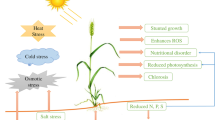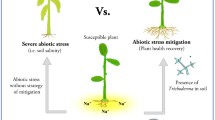Abstract
The allelopathic activity of barley (Hordeum vulgare L. ssp. vulgare) root exudates was studied by comparing their effects on seedling establishment in barley itself and in two weed species, Bromus diandrus Roth. and Lolium rigidum Gaudin, using an original laboratory protocol, named ‘seed-after-seed’. In this protocol, the donor and the receiver species of water-soluble allelochemicals are grown one after the other in the same dishes, in conditions reducing resource competition between both species. Growth of all receptive species (weeds and barley) was inhibited in a dose-dependent manner, when using increasing barley seed densities (0, 8, 19 and 25 seeds per Petri dish). In our conditions, the barley varieties and landraces exhibited different allelopathic activities against weeds or barley. The allelopathic potential of the barley root exudates was also dependent on the receiver species. Indeed, the released allelochemicals proved to be more toxic against the weed plants than on barley itself. Furthermore, the toxicity of the allelochemicals increased after their release by roots, between day 0 and day 6. These allelochemicals might contribute to the plant community dynamics and their usefulness as bio-herbicides deserves further consideration.






Similar content being viewed by others
References
Baghestani A, Lemieux C, Leroux GD, Baziramakenga R (1999) Determination of allelochemicals in spring cereal cultivars of different competitiveness. Weed Sci 47:498–504
Barria BN, Copaja SV, Niemeyer HM (1992) Occurrence of DIBOA in wild Hordeum species and its relation to aphid resistance. Phytochemistry 31:89–91
Ben Haj Salah H, Kilani H, Souissi T, Latiri K, Dahmane ABK (2005) Etude de la biologie du grand brome (Bromus diandrus Roth.) : Cycle de développement du brome seul et en association avec le blé. Revue de L’INAT 20(2):35–49
Ben-Hammouda M, Kremer RJ, Minor HC, Sarwar M (1995) A chemical basis for differential allelopathic potential of sorghum hybrids on wheat. J Chem Ecol 21:775–786
Ben-Hammouda M, Ghorbal H, Kremer RJ, Oueslati O (2002) Autotoxicity of barley. J Plant Nutr 25:1155–1161
Bertholdsson NO (2004) Variation in allelopathic activity over 100 years of barley selection and breeding. Weed Res 44:78–86
Chon SU, Kim YM (2004) Herbicidal potential and quantification of suspected allelochemicals from four grass crop extracts. J Agron Crop Sci 190:145–150
Deghaïs M, El Felah M, Gharbi MS, Zarkouna T, Chakroun M (1999) Les acquis de l’amélioration génétique des céréales en Tunisie. Annales de l’INRAT 72:21–27
Fiers M, Lognay G, Fauconnier ML, Jijakli MM (2013) Volatile compound-mediated interactions between barley and pathogenic fungi in the soil. PLoS ONE 8(6):1–18
Fuerst ER, Putnam AR (1983) Separating the competitive and allelopathic components of interference: theoretical principles. J Chem Ecol 9:937–944
Fujii Y (2001) Screening and future exploitation of allelopathic plant as alternative herbicides with special reference to hairy vetch. J Crop Prot 4:257–275
Gagliardo RW, Chilton WS (1992) Soil transformation of 2(3H)-benzoxazolone of rye into phytotoxic 2-amino-3H-phenoxazin-3-one. J Chem Ecol 18:1683–1691
Gasquez J (2000) Extension des graminées adventices résistantes aux antigraminées foliaires en France. In: Proceedings of the XI international conference on weed biology. Association Française de Protection des Plantes, Dijon, France, pp 485–492
Gfeller A, Laloux M, Barsics F, Kati DE, Haubruge E, du Jardin P, Verheggen FJ, Lognay G, Wathelet JP, Fauconnier ML (2013) Characterization of volatile organic compounds emitted by barley (Hordeum vulgare L.) roots and their attractiveness to wireworms. J Chem Ecol 39:1129–1139
Gianoli E, Niemeyer HM (1998) DIBOA in wild Poaceae: sources of resistance to the Russian wheat aphid (Diuraphis noxia) and the greenbug (Schizaphis graminum). Euphytica 102:317–321
Grün S, Frey M, Gierl A (2005) Evolution of the indole alkaloid biosynthesis in the genus Hordeum: distribution of gramine and DIBOA and isolation of the benzoxazinoid biosynthesis genes from Hordeum lechleri. Phytochemistry 66:1264–1272
Gubbels GH, Kenaschuk EO (1989) Agronomic performance of flax grown on canola, barley and flax stubble with and without tillage prior to seeding. Can J Plant Sci 69:31–38
Hoult AHC, Lovett JV (1993) Biologically active secondary metabolites of barley. III. A method for identification and quantification of hordenine and gramine in barley by high-performance liquid chromatography. J Chem Ecol 19:2245–2254
Inderjit S (2001) Soil: environmental effects on allelochemical activity. Agron J 93:79–84
Inderjit S (2005) Soil microorganisms: an important determinant of allelopathic activity. Plant Soil 274:227–236
Kellner M, Kolodinska Brantestam A, Ahman I, Ninkovic V (2010) Plant volatile-induced aphid resistance in barley cultivars is related to cultivar age. Theor Appl Genet 121:1133–1139
Kremer R, Ben-Hammouda M (2009) Allelopathic plants. 19. Barley (Hordeum vulgare L.). Allelopath J 24(2):225–242
Kushima M, Kakuta H, Kosemura S, Yamamura S, Yamada K, Yokotani-Tomita K, Hasegawa K (1998) An allelopathic substance exuded from germinating watermelon seeds. Plant Growth Regul 25:1–4
Lanoue A, Burlat V, Henkes GJ, Koch I, Schurr U, Röse USR (2010) De novo biosynthesis of defense root exudates in response to Fusarium attack in barley. New Phytol 185:577–588
Laterra P, Bazzalo ME (1999) Seed-to-seed allelopathic effects between two invaders of burned Pampa grasslands. Weed Res 39:297–308
Liu DL, Lovett JV (1993a) Biologically active secondary metabolites of barley. I. Developing techniques and assessing allelopathy in barley. J Chem Ecol 19:2217–2230
Liu DL, Lovett JV (1993b) Biologically active secondary metabolites of barley. II. Phytotoxicity of barley allelochemicals. J Chem Ecol 19:2231–2244
Lodhi MAK, Bilal R, Malik KA (1987) Allelopathy in agroecosystems: wheat phytotoxicity and its possible role in crop rotation. J Chem Ecol 13:1881–1891
Ma SY, Kim JS, Ryang HS (1999) Allelopathic effect of barley to red rice and barnyardgrass. Korean J Weed Sci 19:228–235
Macías FA, Marín D, Oliveros-Bastidas A, Varela RM, Simonet AM, Carrera C, Molinillo JM (2003) Allelopathy as a new strategy for sustainable ecosystems development. Biol Sci Space 17(1):18–23
Mason HE, Spaner D (2006) Competitive ability of wheat in conventional and organic management systems: a review of the literature. Can J Plant Sci 86:333–343
Miller DA (1983) Allelopathic effects of alfalfa. J Chem Ecol 9:1059–1072
Nilsson MC (1994) Separation of allelopathy and resource competition by the boreal dwarf shrub Empetrum hermaphroditum Hagerup. Oecologia 98:1–7
Ninkovic V (2003) Volatile communication between barley plants affects biomass allocation. J Exp Bot 54(389):1931–1939
Olofsdotter M, Navarez M, Rebulanan M, Streibig JC (1999) Weed-suppressing rice cultivars-does allelopathy play a role? Weed Res 39:441–454
Oueslati O, Ben-Hammouda M, Ghorbal MH, El Gazzeh M, Kremer RJ (2005) Barley autotoxicity as influenced by varietal and seasonal variation. J Agron Crop Sci 191:249–254
Oveisi M, Mashhadi HR, Baghestani MA, Alizadeh HM, Badri S (2008) Assessment of the allelopathic potential of 17 Iranian barley cultivars in different development stages and their variations over 60 years of selection. Weed Biol Manag 8:225–232
Overland L (1966) The role of allelopathic substances in the ‘smother crop’ barley. Am J Bot 53:423–432
Petersen J, Belz R, Walker F, Hurle K (2001) Weed suppression by release of isothiocyanates from turnip-rape mulch. Agron J 93:37–43
Putnam AR (1985) Allelopathic research in agriculture: past highlights and potential. In: Thompson AC (ed) The chemistry of allelopathy: biochemical interactions among plants. American Chemical Society, Washington, USA, pp 1–8
Qasem JR, Hill TA (1989) On difficulties with allelopathy methodology. Weed Res 29:345–347
Rice EL (1984) Allelopathy, 2nd edn. Academic Press, Orlando, USA
Ridenour WM, Callaway RM (2001) The relative importance of allelopathy in interference: the effects of an invasive weed on a native bunchgrass. Oecologia 126:444–450
Souissi T, Belhadjsalah H, Mhafdhi M, Latiri K (2000) Non chemical control of Bromus diandrus Roth. in wheat in Tunisia. In: Proceedings of the XI International Conference on Weed Biology. Association Française de Protection des Plantes, Dijon, France, pp 417–424
Souissi T, BelhadjSalah H, Latiri K (2001) Brome in cereal crops: infestations and management. L’Investisseur Agricole 42:29–32
Souissi T, Labidi S, Ben Hadj Salah H (2004) Mise en évidence et origine de la résistance herbicide aux raygrass (Lolium rigidum Gaud.) dans les cultures de blé. Revue de L’INAT 19(1):149–161
Vasilakoglou I, Dhima K, Lithourgidis A, Eleftherohorinos I (2009) Allelopathic potential of 50 barley cultivars and the herbicidal effects of barley extract. Allelopath J 24(2):309–320
Viard-Crétat F, Gallet C, Lefebvre M, Lavorel S (2009) A leachate a day keeps the seedlings away: mowing and the inhibitory effects of Festuca paniculata in subalpine grasslands. Ann Bot 103:1271–1278
Weidenhamer JD (1996) Distinguishing resource competition and chemical interference: overcoming the methodological impasse. Agron J 88:866–875
Wu H, Haig T, Prately J, Lemerle D, Lemerle D, An M (2000a) Distribution and exudation of allelochemicals in wheat Triticum aestivum. J Chem Ecol 26:2141–2154
Wu H, Prately J, Lemerle D, Haig T (2000b) Evaluation of seedling allelopathy in 453 wheat (Triticum aestivum) accessions against annual ryegrass (Lolium rigidum) by the equal-compartment-agar method. Aust J Agric Res 51:937–944
Zhang S, Liu J, Bao X, Niu K (2011) Seed-to-seed potential allelopathic effects between Ligularia virgaurea and native grass species of Tibetan alpine grasslands. Ecol Res 26:47–52
Acknowledgments
During this work, the first author was recipient of a PhD fellowship of the Erasmus Mundus Averroès Partnerships Action of the European Commission. We would like to thank François Rochet for her valuable help in statistical analysis. This work was funded by internal grants of Gembloux-Agro Bio Tech, University of Liège, Belgium.
Author information
Authors and Affiliations
Corresponding author
Additional information
Handling Editor: S. Raghu.
Rights and permissions
About this article
Cite this article
Bouhaouel, I., Gfeller, A., Fauconnier, ML. et al. Allelopathic and autotoxicity effects of barley (Hordeum vulgare L. ssp. vulgare) root exudates. BioControl 60, 425–436 (2015). https://doi.org/10.1007/s10526-014-9634-3
Received:
Accepted:
Published:
Issue Date:
DOI: https://doi.org/10.1007/s10526-014-9634-3




